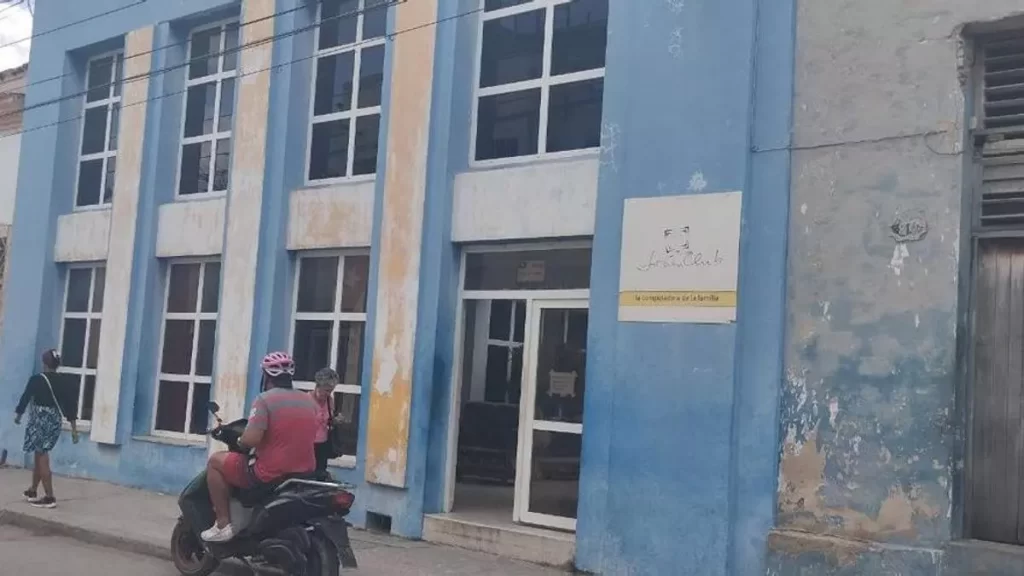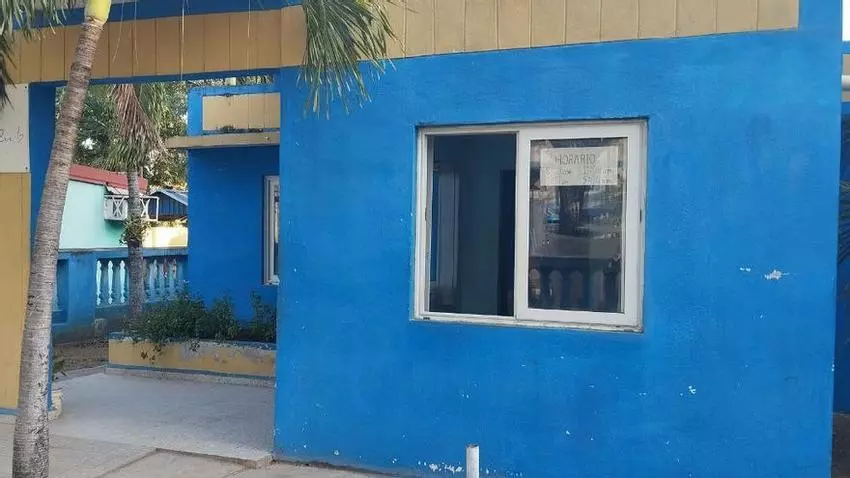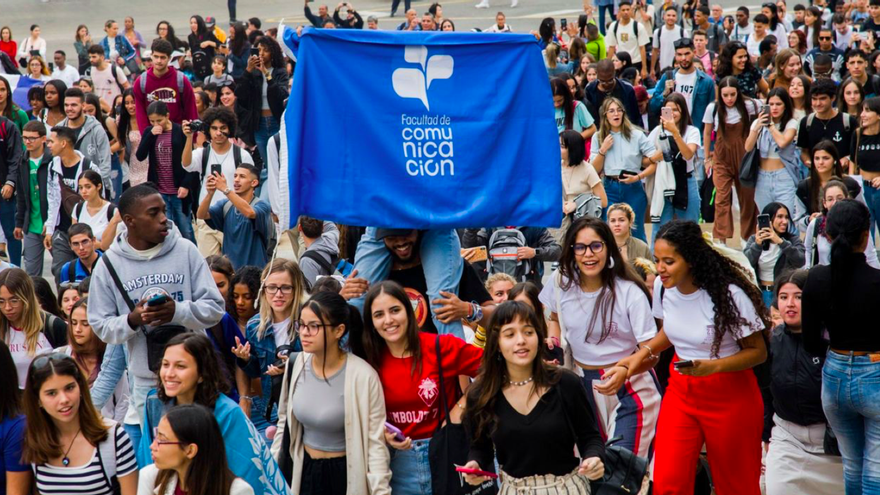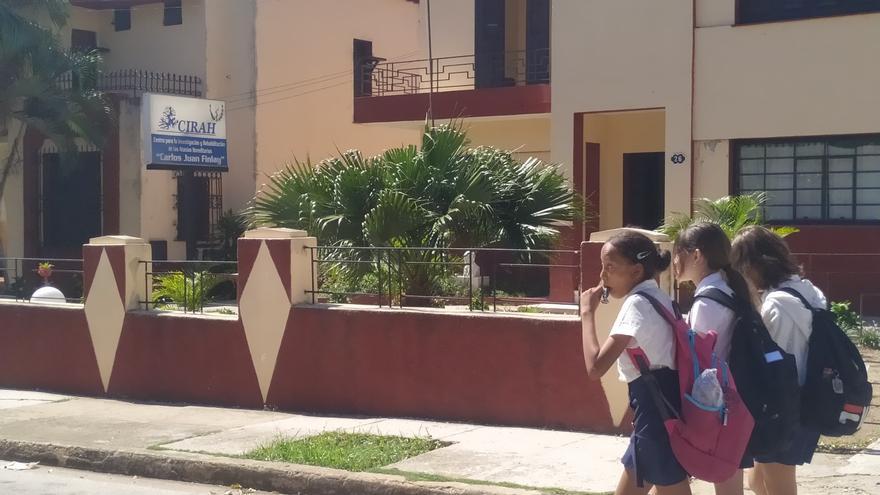
![]() 14ymedio, Havana / Holguín, Lucía Oliveira and Miguel García, 3 March 2024 — Where before there were tables with screens and keyboards, now there are boxes of vegetable oil, piles of spaghetti packages and bags of powdered milk piled up. Two of the most important buildings of the Youth Computer and Electronics Club in Holguín have been leased as warehouses to small private companies in the city. The initiative, originally created in 1987 to be the computer spearhead of the Cuban regime, has been in frank deterioration for years.
14ymedio, Havana / Holguín, Lucía Oliveira and Miguel García, 3 March 2024 — Where before there were tables with screens and keyboards, now there are boxes of vegetable oil, piles of spaghetti packages and bags of powdered milk piled up. Two of the most important buildings of the Youth Computer and Electronics Club in Holguín have been leased as warehouses to small private companies in the city. The initiative, originally created in 1987 to be the computer spearhead of the Cuban regime, has been in frank deterioration for years.
The economic crisis has hit the Youth Club network hard, because it needs frequent investments in computer equipment. “The machines are now very old, and we piled up some of them in a corner because they don’t even turn on,” an employee of the Lenin neighborhood premises in this eastern Cuban city tells 14ymedio.
“It’s been months since we became a warehouse for the products of private businesses in the area,” the worker admits. “The management of the Holguín Youth Club must collect eight million pesos per month for services, but since we provide fewer and fewer of our own services to the population, we have to make money in a different way.”
Previously, the money was obtained from customers who paid for “machine time” by renting a computer for a few hours, which teenagers and children from nearby neighborhoods used mainly to play video games. But most of the money came from the State budget, which thought of this initiative as the “apple of their eye.” continue reading
“Any little kid now has a mobile phone that is much better than the computers we had here”
“We also offered antivirus updates, a copy of the Ecured encyclopedia and La Mochila* (an official alternative to the ‘weekly packet’ [a collection of TV shows, music and digital material, much of it from abroad]). In recent years we didn’t have much, especially after people were able to connect to Wi-Fi networks and the internet,” he emphasizes.
The arrival, in December 2018, of the web browsing service through mobile telephony seems to have struck a mortal blow to a Youth Club network that was initially designed to centralize the use of new technologies. “Any little kid now has a mobile phone that is much better than the computers we had here. If they don’t have one, they ask their parents or a friend and can download and play whatever they want.”
Despite its loss of social importance, the Youth Club for Computation and Electronics continues to be defined on its digital site as “a network of technological centers, with computer solutions” at the fingertips of any Cuban. It adds that it has “a wide portfolio of products and services,” but a tour of its Holguin center points in another direction.
The entity’s office in the Pueblo Nuevo neighborhood is closed. “We don’t have a reopening date at the moment,” a custodian tells this newspaper. “Perhaps when we reopen there will be a store here because that’s what is being done with the others,” he says. Outside, the unpainted facade and a sign with faded colors are far from the impeccable presence that the Youth Club once had.
“All this fell out of favor with the departure of Fidel Castro from the leadership of the country, because everyone knows that this was a project of his”
“All this fell out of favor with the departure of Fidel Castro from the leadership of the country, because everyone knows that this was a project of his,” María Victoria Contreras, a worker for two decades at the Havana Youth Club, tells this newspaper. “I was among the founders, and I can say that here the resources were endless. Unlike other sectors, we lacked nothing.”
Contreras says that at first they had a lot of demand, “even a line outside, because almost no one had a computer at home, and the kids wanted to sit in front of a screen, touch a mouse. I saw many children play with a keyboard for the first time when I worked at the Club; there are things you never forget.”
“The first Youth Club that was inaugurated was the one on N Street, between 21st and 23rd next to the Cuban Pavilion in Havana,” recalls the retiree. “The technology we had at that time was keyboards with monochrome screens, which was a success for us.” However, “now investments are needed to build this network, and the money no longer arrives as before.”
Yordanis, a teenager in the 80s, discovered his passion in those places after spending several hours in line to gain access. Now a graduate of computer engineering, he recognizes the importance of the Youth Club in his life but considers that the project “was not updated at the same pace as the technologies.” For this professional, “the infrastructure has not been modernized, internet access is poor, and the user experience leaves a lot to be desired.”

“You can’t start a state-of-the-art video game on a computer where the mouse doesn’t work well, the keyboard lacks letters or the screen can’t support the definition of graphics for the current interfaces. It’s frustrating and, in addition, people don’t want others to be looking over their shoulder at what they’re doing,” he adds.
The Central Palace of Computing and Electronics, located at the intersection of Amistad and Reina streets in front of Fraternidad Park, in Central Havana, is the largest installation of this type in the whole country. The property has undergone all kinds of transformations and different uses throughout its more than six decades of existence.
First, the colossal building was the headquarters of the American Sears chain in Havana. Nationalized after the coming to power of Fidel Castro in 1959, the place spent years closed to the public and converted into bureaucratic offices. In the 1980s it was inaugurated as the Centro market, a free trade experiment that lasted a short time and fell out of favor during the process of Rectification of Errors and Negative Tendencies of 1986.
The old Sears building experienced another period of closure until 1991, when it reopened its doors as a Computer Palace. “Its huge rooms and many floors were always too complicated for this new function because it has always seemed more like a large store than a place to go to use a computer,” acknowledges a founding worker of the place.
“As he did with other emblematic buildings of Havana, he decided that the old Sears was not going to be dedicated to consumption nor was it going to give one more peso to anyone”
“But Fidel wanted to teach a lesson to all those people who were going to stand in line at the Centro market in the early hours of the morning to buy and resell the jams, beers and tins of cumin on the black market,” he says. “As he did with other emblematic buildings in Havana, he decided that the old Sears was not going to be dedicated to consumption nor was it going to give one more peso to anyone.”
“In those days we also gave courses to learn how to use programs and other tools, we even had a Geroclub for older people who wanted to approach a computer for the first time, but that is no longer done,” the former employee tells 14ymedio. “This was a political project rather than a computer project. It was designed to create the “New Man” in computing, and that objective was lost.”
The former worker of the Youth Club believes that the extension of new technologies “changed everything.” Cubans “prefer to enjoy a movie, a game or a videoconference at home with some friends or sitting in a park, but those facilities are more and more abused every day and don’t even make you want to sit in one.”
“Now there are other priorities,” the employee summarizes. In the list of preferences, the new forms of economic management are winning over the old official programs, marked by massiveness and bulky budgets. The city of Holguín is going at full speed in that reconversion; where before it was about getting online to play games or program, now it’s about buying rice and liquid detergent.
*Translator’s note: *La Mochila (Backpack) contains official State content as opposed to El Paquete (the Weekly Packet), which contains non-political content and is bought on the black market.
Translated by Regina Anavy
____________
COLLABORATE WITH OUR WORK: The 14ymedio team is committed to practicing serious journalism that reflects Cuba’s reality in all its depth. Thank you for joining us on this long journey. We invite you to continue supporting us by becoming a member of 14ymedio now. Together we can continue transforming journalism in Cuba.


